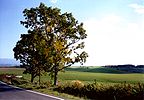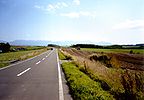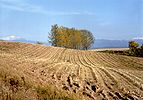Biei, Hokkaido
You can help expand this article with text translated from the corresponding article in Japanese. (June 2022) Click [show] for important translation instructions.
|
Biei
美瑛町 | |
|---|---|
Town | |
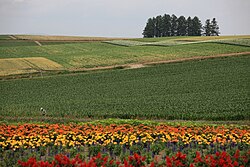 | |
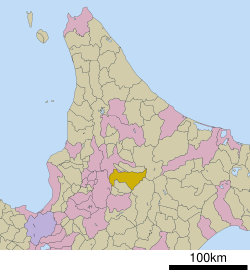 Location of Biei in Hokkaido (Kamikawa Subprefecture) | |
| Coordinates: 43°35′N 142°28′E / 43.583°N 142.467°E | |
| Country | Japan |
| Region | Hokkaido |
| Prefecture | Hokkaido (Kamikawa Subprefecture) |
| District | Kamikawa (Ishikari) |
| Government | |
| • Mayor | Satoshi Hamada |
| Area | |
• Total | 677.16 km2 (261.45 sq mi) |
| Population (September 30, 2016) | |
• Total | 10,374 |
| • Density | 15/km2 (40/sq mi) |
| Time zone | UTC+09:00 (JST) |
| City hall address | 4-6-1 Motomachi, Biei-chō, Kamikawa-gun, Hokkaidō 071-0292 |
| Website | www |
| Symbols | |
| Flower | Lily of the Valley |
| Tree | Japanese White Birch |
Biei (美瑛町, Biei-chō) is a town located in Kamikawa Subprefecture, Hokkaido, Japan. As of September 2016, the town has an estimated population of 10,374, and a density of 15 persons per km2. The total area is 677.16 km2.
Overview
[edit]Biei is famous for its views of wide fields and hills, and is used as a backdrop for many Japanese commercials and TV programmes. The bright colours of its fields attract thousands of visitors in July and August.
The town also houses the Shinzo Maeda Photo Art Gallery.
Since 1992, Biei has held the "Biei Healthy Marathon", which attracts runners from all around Japan.[1]
Geography
[edit]Biei is located between the cities of Asahikawa and Furano, below the Tokachidake mountain range[2] in northern Hokkaido.[3] The sloping hills of Biei are the product of pyroclastic plateaus, which are the results of ash from volcanic eruptions.[4] Biei has 676.78 km2 of land, of which 70% is used for forestry and 15% is used for agriculture.[2]
History
[edit]After the establishment of Hebetto, now Asahi, in 1894, Biei village separated from Kaguru village in 1900.[2] Biei Town was established in 1940 and the Agricultural cooperative model was implemented in 1947. [5] In 1950, hot springs were discovered and the Tourist Association was established the following year of 1951.[5]
Mt. Tokachi had five eruptions, the first one recorded in the Edo period, which led to the establishment of measures in preparation for natural emergencies in Biei, which includes emergency response training by residents and organisations.[2]
Demographic
[edit]As of May 2024, the Biei population total is 9343 people, with the largest demographic age group being 70-74 years old with a total of 812 people followed by the 50-54 year old group with 700 people.[6]
Education
[edit]The Biei Town Board of Education Administration Division runs the schools, which include 5 Elementary School,[7] 2 Junior High Schools,[7] and 1 High School.[8]
Government
[edit]Biei is governed by the Mayor and the town council. The members in the council are elected every four years. There are 14 members as of 2024 until 30 April 2027.[9]
Economy
[edit]The core industry in Biei is agriculture and tourism.[2]
Agriculture
[edit]Japanese Agriculture (JA) Biei, an entrepreneurial co-operative consists of 741 members and is a part of the Japanese Agriculture Co-operative.[10] The main agricultural production was rice until 1983 when potatoes, beets, beans, wheat and other seasonal crops were introduced and cultivated in cycles.[5] Biei is providing direct payment subsidies to have sustainable development in the agricultural sector and stimulate the interest in farming.[11]
Tourism
[edit]The discovery of Shirogane Onsen hot springs in 1950[12] started Biei tourism and established the brand of the town as "Biei, the Town of Hills."[13] The hot springs were drilled out from 399m deep in the ground and are measured to be 48 °C.[12] Festivals such as "Dokanto Agriculture Festivals," "Biei Encounter Festivals," and "Nachi Biei Fire Festival" are hosted to increase tourism, which is a collaboration by the residents and local organisations.[14]
As of 2018, there were over 2.2 million tourists visiting Biei which increased incidents of trespassing into farms and causing trampling of crops.[15] There are reports of illegal drones flying over private land as well as discussions regarding potential transfer of outside species introduced into the crops through trespassing tourists.[16]
The Biei council established the Biei Town Tourism Master Plan in 2020 that aims to improve the behaviour of visitors and improve Biei tourism[17]
Local Attractions
[edit]
Patchwork Road
[edit]Patchwork Road, named after the pattern of the field from aerial perspective, is located in the northwest of the town centre. It is known for the green colour in the summer and the white from the layer of snow during winter.[18] The field consists of trees specifically known for the image used in commercials: Mild Seven Hill, Ken and Mary Tree, Seven Star Tree, as well as Parents and Child Tree which consists of oaks.[18] Hokusei Hill Observatory is also located within the area, which is known for its pyramid-shaped form, next to the flower park called Zerubu Hill.[18]
Panorama Road
[edit]Panorama Road consists of fields that are explored with vehicles such as cars or bicycles.[18] The field includes Shikisai Hill, a flower park known for its lavender and other flowers and its trail within it; and Kanno Farm, which is a park located next to the main road between Biei and Furano.[18]

Shirogane Blue Pond
[edit]Shirogane Blue Pond is known for its colour of the water and the Japanese larch trees that surround the area.[19] The colour of the pond was the result of the aluminium added into the water to control the mudslides.[20]
Museum
[edit]The Misora Hillside Local history Museum focuses on local history and astronomy. It has "Bichu" the observatory, which holds a 400mm reflecting telescope, 150mm refracting telescope, and a telescope for solar surface observation.[21]

Transportation
[edit]The main access to Beiei is by train, bus, and car through Asahikawa and Furano, or by plane from Asahikawa. [22] There is also a train from Sapporo Station to Asahikawa Station.[23]
Climate
[edit]| Climate data for Biei, Hokkaido (1991−2020 normals, extremes 1977−present) | |||||||||||||
|---|---|---|---|---|---|---|---|---|---|---|---|---|---|
| Month | Jan | Feb | Mar | Apr | May | Jun | Jul | Aug | Sep | Oct | Nov | Dec | Year |
| Record high °C (°F) | 6.0 (42.8) |
11.4 (52.5) |
14.9 (58.8) |
27.0 (80.6) |
34.4 (93.9) |
36.0 (96.8) |
36.1 (97.0) |
37.1 (98.8) |
32.7 (90.9) |
25.7 (78.3) |
20.2 (68.4) |
12.1 (53.8) |
37.1 (98.8) |
| Mean daily maximum °C (°F) | −3.9 (25.0) |
−2.6 (27.3) |
2.0 (35.6) |
10.2 (50.4) |
18.0 (64.4) |
22.3 (72.1) |
25.7 (78.3) |
25.8 (78.4) |
21.3 (70.3) |
14.2 (57.6) |
5.6 (42.1) |
−1.6 (29.1) |
11.4 (52.6) |
| Daily mean °C (°F) | −8.7 (16.3) |
−7.9 (17.8) |
−3.0 (26.6) |
4.4 (39.9) |
11.3 (52.3) |
15.9 (60.6) |
19.7 (67.5) |
20.0 (68.0) |
15.2 (59.4) |
8.3 (46.9) |
1.5 (34.7) |
−5.5 (22.1) |
5.9 (42.7) |
| Mean daily minimum °C (°F) | −14.8 (5.4) |
−14.7 (5.5) |
−9.1 (15.6) |
−1.3 (29.7) |
4.7 (40.5) |
10.0 (50.0) |
14.7 (58.5) |
15.2 (59.4) |
9.8 (49.6) |
3.0 (37.4) |
−2.9 (26.8) |
−10.8 (12.6) |
0.3 (32.6) |
| Record low °C (°F) | −33.2 (−27.8) |
−32.7 (−26.9) |
−27.5 (−17.5) |
−14.2 (6.4) |
−4.7 (23.5) |
−0.9 (30.4) |
3.8 (38.8) |
4.7 (40.5) |
−0.6 (30.9) |
−6.0 (21.2) |
−20.8 (−5.4) |
−27.3 (−17.1) |
−33.2 (−27.8) |
| Average precipitation mm (inches) | 41.1 (1.62) |
38.3 (1.51) |
47.0 (1.85) |
49.5 (1.95) |
68.5 (2.70) |
69.5 (2.74) |
121.2 (4.77) |
168.3 (6.63) |
129.0 (5.08) |
96.0 (3.78) |
94.5 (3.72) |
73.5 (2.89) |
996.4 (39.24) |
| Average snowfall cm (inches) | 164 (65) |
141 (56) |
129 (51) |
28 (11) |
0 (0) |
0 (0) |
0 (0) |
0 (0) |
0 (0) |
3 (1.2) |
79 (31) |
182 (72) |
726 (287.2) |
| Average rainy days | 15.2 | 13.1 | 13.6 | 11.4 | 11.0 | 9.9 | 10.9 | 11.7 | 12.3 | 14.1 | 17.9 | 18.2 | 159.3 |
| Average snowy days | 21.1 | 18.8 | 17.0 | 3.3 | 0 | 0 | 0 | 0 | 0 | 0.4 | 8.2 | 21.1 | 89.9 |
| Mean monthly sunshine hours | 67.5 | 83.2 | 122.1 | 154.0 | 181.5 | 166.0 | 161.6 | 156.2 | 149.8 | 123.4 | 60.1 | 47.9 | 1,473.3 |
| Source 1: JMA[24] | |||||||||||||
| Source 2: JMA[25] | |||||||||||||
Gallery
[edit]-
The Patchwork Road
-
Tree of "Ken and Merry"
-
Tree of a parent and a child
-
Tree of philosophy
References
[edit]- ^ Biei Healthy Marathon official website Main page Archived 2011-06-25 at the Wayback Machine (in Japanese)
- ^ a b c d e 北海道美瑛町. "まちの概要". 北海道美瑛町 (in Japanese). Retrieved 2024-06-23.
- ^ Organization, Hokkaido Tourism (2022-02-02). "Area Guide "Northern Hokkaido"|HOKKAIDO LOVE! -Hokkaido Official Tourism Site". Hokkaido Official Tourism Site HOKKAIDO LOVE!. Retrieved 2024-06-23.
- ^ "Diving Deep Into Hokkaido's Defining Quality – its Unparalleled Geography – HOKKAIDO LOVE!". Retrieved 2024-06-23.
- ^ a b c "歴史|一般社団法人 美瑛町観光協会". 一般社団法人 美瑛町観光協会. Retrieved 2024-06-23.
- ^ 北海道美瑛町. "人口・世帯". 北海道美瑛町 (in Japanese). Retrieved 2024-06-23.
- ^ a b 北海道美瑛町. "小学校・中学校". 北海道美瑛町 (in Japanese). Retrieved 2024-06-23.
- ^ 北海道美瑛町. "美瑛高校". 北海道美瑛町 (in Japanese). Retrieved 2024-06-23.
- ^ 北海道美瑛町. "議会". 北海道美瑛町 (in Japanese). Retrieved 2024-06-23.
- ^ "Japanese farmers to learn from Tasmanian partnership". Premier of Tasmania. Retrieved 2024-06-23.
- ^ 北海道美瑛町. "美瑛の農業". 北海道美瑛町 (in Japanese). Retrieved 2024-06-23.
- ^ a b "温泉|一般社団法人 美瑛町観光協会". 一般社団法人 美瑛町観光協会. Retrieved 2024-06-23.
- ^ 北海道美瑛町. "美瑛の観光業". 北海道美瑛町 (in Japanese). Retrieved 2024-06-23.
- ^ 北海道美瑛町. "美瑛の観光業". 北海道美瑛町 (in Japanese). Retrieved 2024-06-23.
- ^ "A small town in Hokkaido enters the spotlight | NHK WORLD-JAPAN News". NHK WORLD. Retrieved 2024-06-23.
- ^ Sekarani, Wulan; Widiandari, Arsi (2023-12-11). "Overtourism and Global Challenges on Environmental Issues: A Case Study of Japanese Tourism". Proceedings International Conference of Culture and Sustainable Development. 1 (0). ISSN 3031-5794.
- ^ 北海道美瑛町. "美瑛町観光マスタープラン". 北海道美瑛町 (in Japanese). Retrieved 2024-06-23.
- ^ a b c d e "Biei". www.japan-guide.com. Retrieved 2024-06-23.
- ^ Organization, Hokkaido Tourism. "Shirogane Blue Pond|What to See & Do|HOKKAIDO LOVE! -Hokkaido Official Tourism Site". Hokkaido Official Tourism Site HOKKAIDO LOVE!. Retrieved 2024-06-23.
- ^ "白金青い池|一般社団法人 美瑛町観光協会". 一般社団法人 美瑛町観光協会. Retrieved 2024-06-23.
- ^ 北海道美瑛町. "丘のまち郷土学館「美宙」". 北海道美瑛町 (in Japanese). Retrieved 2024-06-23.
- ^ Organization, Japan National Tourism. "Biei | Travel Japan - Japan National Tourism Organization (Official Site)". Travel Japan. Retrieved 2024-06-23.
- ^ "Springtime in Hokkaido's Biei–Furano". JRPass.com. Retrieved 2024-06-23.
- ^ 観測史上1~10位の値(年間を通じての値). JMA. Retrieved February 17, 2022.
- ^ 気象庁 / 平年値(年・月ごとの値). JMA. Retrieved February 17, 2022.
External links
[edit] Media related to Biei, Hokkaidō at Wikimedia Commons
Media related to Biei, Hokkaidō at Wikimedia Commons Biei travel guide from Wikivoyage
Biei travel guide from Wikivoyage- Official Website (in Japanese)






